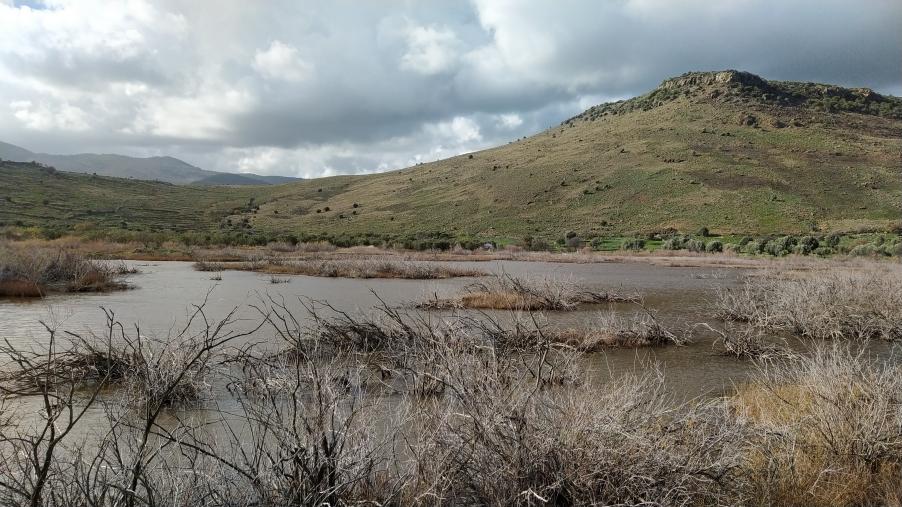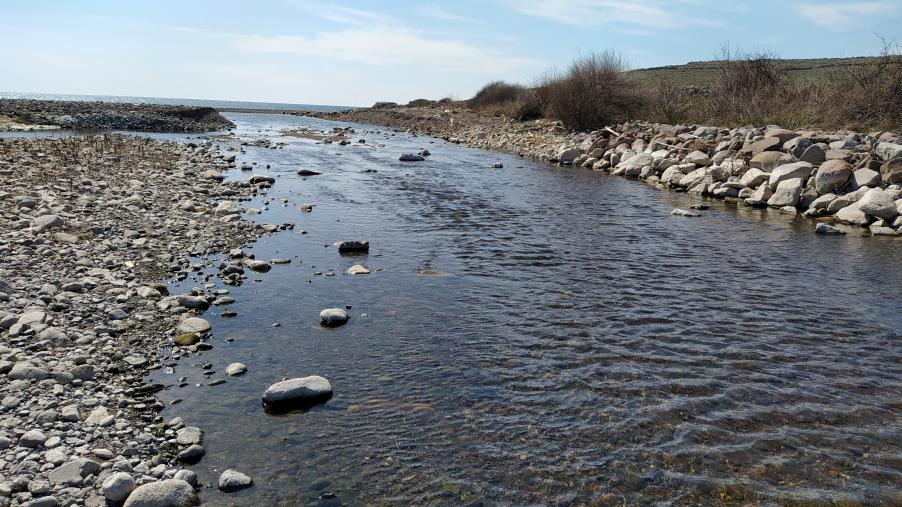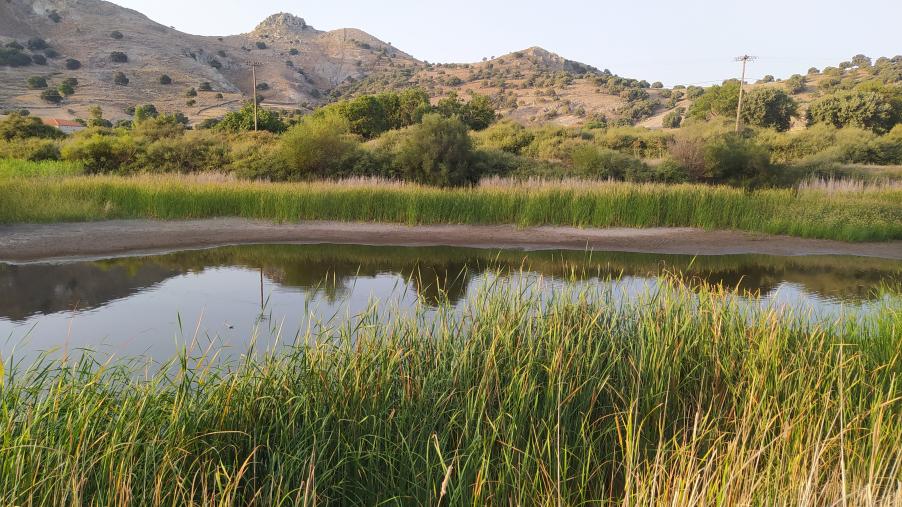Wetlands
The WWF Greece conducted a full recording of the greek wetlands on the islands of the Aegean Sea (Crete excluded) in 2007. The island of Lesvos came in first place with 63 wetlands! Most of them are found around the perimetre of the Kalloni and the Gera Gulf.
Kalloni Gulf wetlands
The Kalloni Gulf protected area (SAC and SPA) includes 25 different wetlands, most of them coastal.

Nifida marsh
Polichnitos area
- It is located by the Nifida village (Southwest Kalloni Gulf, near Polichnitos).
- t is formed by winter rainfall and dries up completely during the summer period!
- In winter Greater Flamingos, Teals, herons, Coots, Little Grebes, White Wagtails, and other species that forage or roost in such wetlands in winter can be found there.
- In Spring it is one of the very first places to see migrants uch as waders, wagtails, and hirundines.

Polichnitos Salt Pans
Polichnitos area
- It is located north of the Skala Polichnitos, just next to the last houses of the village
- Together with adjacent wetland areas (saltmarshes and seasonal ponds), it forms a 96 hectares wide wetland- nearly half the size of the Kalloni Pans.
- This week the usual overwintering bird species are recorded here: Avocets, Flamingos, Shelducks, Black Storks, etc.
- It is a paradise for shorebirds, year-round. Also a very popular site for birders thanks to a drivable track that runs its perimeter, enabling the best of views and from a close distance.

Alykoudi marsh
Polichnitos area
- It is located 3 km NW of the Lisvori village (east coast of the Kalloni Gulf).
- It is a brackish marsh (west part) and a freshwater marsh (east part) separated from the sea by a thin line of land.
- It dries out during summer to be flooded again the following winter.
- In winter, the usual overwintering species are recorded here: Flamingos, Shelducks and other ducks, Yellow-legged Gulls, etc
- Alykoudi marsh is a very rewarding site to observe waders and other wetland birds during their spring passage (which is about to start!!) and an important breeding area for the Pied Avocet, Kentish Plover, and the Black-winged Stilt.

Messa wetland
Agia Paraskevi area
- The third-largest wetland of the island (1,4 sq. km) and is located by the main Mitili-Kalloni road and the conjunction to Achladeri (to Polichnitos).
- It is formed by several different types of wetlands such as a lagoon, 2 torrents (Kalami and Kryoneri), salt and fresh water marshes, and the coastal zone!
- During autumn and winter, it takes a marron color thanks to the plant Glasswort (Salicornia europea), a special plant of the habitat “Mediterranean salt-marshes” that is tolerant to salt.
- In winter, the usual overwintering bird species are recorded here: Greater Flamingos, Ruddy Shelducks, Wigeon, Dalmatian Pelicans, herons, cormorants, Little Grebes e.t.c.

Kalami marsh
Agia Paraskevi area
- It is located at the western parts of the Messa wetland, in the Agia Paraskevi region, right at the conjunction of the main road towards Achladeri and Polychnitos.
- It is formed by the torrent Kalami as it becomes blocked by the coastline and, in contrast to most of the wetland area, it is formed by freshwater.
- Only the parts of the estuary retain water through the summer months, in most years.
- Flamingos, Shelducks, Mallards, Coots, Green Sandpipers, Kingfisher, etc. were recorded there, a few days ago.
- It is an excellent site to observe migrating waders, herons, and waterfowl during the spring passage – that has already started!
- This wetland is a breeding area for the Little Ringed Plover, Coot, Water Rail, Mallard, Black-winged Stilt, Zitting Cisticola, the Eastern Speadfoot, Levant Water Frog, and several species of Damselflies and Dragonflies.
Milopotamos estuary
Agia Paraskevi area
- The river is located 2,5 km to the SW of Agia Paraskevi and its estuary is between the Kalloni Salt Pans and the Messa wetland.
- Milopotamos River springs are found within the pine forest and it is formed by two tributary streams that meet 4 km away from the sea.
- The estuary, which is 0,70 hectares wide, joins with one end of the peripheral canal of the Kalloni Pans.
- A few days ago, Flamingos, Cormorants, yellow-legged, Black-headed and Slender-billed Gulls, Greenshanks, Kingfishers, etc. were recorded here.
- It is an exceptional site to observe migrant birds as the river vegetation is left relatively intact (reeds and tamarisks).
- Every year, the estuary and lower parts of its bed support breeding pairs of Little Ringed and Kentish Plover, Ruddy and Common Shelducks, Nightingales, Olivaceous and Cetti’s Warblers, Bee-eaters, etc.
Skala Kalloni marsh
Kalloni area
- It is located at the west end of the village of Skalla Kallonis, within the hotel area.
- It covers an area of 7,6 hectares and in its recent condition is predominately formed by winter rainfall.
- In Spring it becomes is a true magnet for migrant birds- and birdwatchers!
- This week the usual overwintering bird species are recorded here: Teals, and other duck species, Coots, Moorhens, egrets e.t.c.
- It is an important area for amphibians (Tree frog, Eastern Speadfoot, Balkan Water Frog) and reptiles (Grass Snake, Balkan, and Pond Terrapins) but also Dragonflies!!

Metochi lake
Kalloni area
- It is located at 1,5 km SW of the village of Kalloni and is one of the few wetlands of the Kalloni Gulf protected area that is not coastal.
- Although 2,5 km away from the Ennia Kamares river mouth but is part of the same river bed. Nevertheless, it is considered a distinct wetland as it remains flooded throughout the summer months.
- Besides its small size, it is one of the most popular sites for birders- both during Spring and Autumn.
- A very important area for reptiles (Striped and Pond Terrapin, Grass and Pond Snake) and amphibians of the island (toads and frogs).
Keramia (potamia) Dam
Kalloni area
- It is located 4km W- SW of Kalloni and other wetlands nearby are the Potamia River (to the south), Ennia Kamares (E), and Metochi Lake (NE).
- It is an artificial wetland.
- It retains water throughout the summer months.
- It is almost 10 ha wide.
- Common bird species to find there are Little grebes and coots, Cormorants and more rare species such as Ferruginous Duck, Qarganeys and during extremely harsh winters even Mute Swans!
- It supports a large population of Striped Terrapins.
Parakoila marsh
Parakoila area
- It is located 1,5 km north of the Parakila village (west parts of the Kalloni Gulf) and it is accessible from the main Kalloni- Agra road.
- Its water used to be mainly brackish, as it receives water through underground connection with the sea, but in the last decades, large quantities of freshwater are also accumulated from recently created drills.
- In winter, the usual overwintering bird species are recorded here: Great White Egrets, White Egrets, Yellow-legged Gulls, Little Grebes, Kingfishers, etc.

Parakila Lagoon
Parakila area
We present to you the Parakila Lagoon:
- It is located 1 km south of the Parakila village (west parts of the Kalloni Gulf) and it is accessible from the main Kalloni- Agra road.
- It is the borderline of the Parakila olive grove and the garrigue-Sweet Chestnut areas of Western Lesvos.
- Its water is mainly brackish, as it is connected to the Kalloni Gulf sea.
- This week the usual spring bird species are recorded here: Grey Herons, Little White Egrets, Black Stork, Yellow Wagtails, etc.

Makara estuary
Agra area
- It is located on the western side of the Kalloni Gulf mouth, 4km SW of Apothika (Agra area).
- It is formed by the torrent Makara which later in Spring becomes blocked and retains freshwater for several months- in some years, even towards the end of summer.
- Yellow-legged Gulls (that go there to wash their feathers off the salt), Little Ringed Plovers, Cormorants, Shags, and Barn Swallows were recorded there a few days ago.
- The wetland also supported good numbers of early stages tadpoles and a small population of Balkan Terrapins.
- It is protected by the Presidential Law of “Small Insular Wetlands of Greece”.


Β- ΥΓΡΟΤΟΠΟΙ ΔΥΤΙΚΗΣ ΛΕΣΒΟΥ - ΑΠΟΛΙΘΩΜΕΝΟΥ ΔΑΣΟΥΣ
Στην ομάδα αυτή περιλαμβάνονται οι υγρότοποι που απαντώνται στη δυτική χερσόνησο του νησιού της Λέσβου και περιλαμβάνονται είτε στα όρια της ΕΖΔ GR4110003 και της ΖΕΠ GR4110010 αλλά και στο ΠΔ για την προστασία των μικρών νησιωτικών υγροτόπων.
Mesotopos pools
Mesotopos and Eressos area
- they are located on both sides of the Mesotopos to Eressos main road (3 km before reaching Eressos)
- their area is 6,5 ha wide
- they have been artificially created by the extensive removal of soil from the area
- it is one of the very few wetlands on the island that retain freshwater bodies throughout the summer months
- a magnet for migrating wetland birds both in spring and autumn (as early as the late summer months)
- a very important area for reptiles (terrapins and grass and pond snakes) and amphibians (frogs and toads) but also Dragonflies and Damseflies



